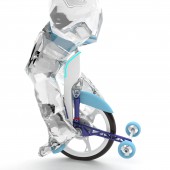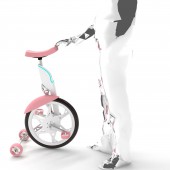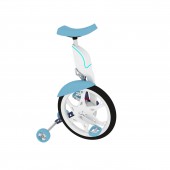Unio Electric Unicycle by Chang-Yu Pan |
Home > Winners > #40703 |
 |
|
||||
| DESIGN DETAILS | |||||
| DESIGN NAME: Unio PRIMARY FUNCTION: Electric Unicycle INSPIRATION: This project try to involve the Gyro automatic balance system and electric power in unicycle. This concept not only down low the unicycle's ridding threshold but improve the performance for daily use. The design is on the structure of a single wheel device which can be driven by both human and electric power. UNIQUE PROPERTIES / PROJECT DESCRIPTION: Unio is an electric assisted unicycle with automatic balanced system. The main design purpose is to put the highly skill unicycles into daily life use. By the Unio, the user can use the same skills for usual bikes to ride it. In a couple of hours, you will become an expert. Traveling forward and back, and glide to either side will not be a problem. Unio are more agile and slippery than a bicycle. We can significantly save the occupied parking area up to 50% compared to the bicycle, and it is more friendly to the pedestrian when riding at crowded street. OPERATION / FLOW / INTERACTION: User can use the same skills for usual bikes to ride Unio. Basically, user lean himself weight forward to accelerate, lean backwards to brake, and lean left or right and spin your arms to turn. With practice user can get more graceful and relaxed and keep your arms mostly by your side. The novel tail wheel is designed for easy parking. Its agencies combined actuation of the damping. It can be automatically held high while riding, therefore, give the user friendly feelings. When the battery power is low, the drum motor is only responsible for the automatic balance, and the moving power must rely on user pedaling. PROJECT DURATION AND LOCATION: The project started in 2011 at Kao Yuan University Kaohsiung. and finished in Spring 2012 in Green Tech Contest, Taipei. and was exhibited in 63th iENA in October 2012. FITS BEST INTO CATEGORY: Vehicle, Mobility and Transportation Design |
PRODUCTION / REALIZATION TECHNOLOGY: Unio is made of aluminum alloy. The lithium battery is placed in the hollow portion of the frame. The body is assembly by two components, tail arm and the wheel arm. Wheel arm is the main body, tail arm is for easy parking and push go. The Unio incorporates regenerative braking strategies to utilize energy. As user lean backwards to slow down, the Unio turns the motor into a brake/generator, capturing kinetic energy and send it back to the battery for later use. SPECIFICATIONS / TECHNICAL PROPERTIES: There is not a lot of room for batteries and big motor, so the range is somewhere around 10-15 km. The speed is about 10-15 km/h. The Unio drum motor can be manipulated for movement and automatic attitude balance. When the battery power is low, the drum motor is only responsible for the automatic balance, and the moving power must rely on human pedaling. H :65-85 cm W:60 cm L :70 cm Weigth :8 Kg. TAGS: Unicycle, Gyro, Auto balance, Electric Unicycle, Pedestrian friendly RESEARCH ABSTRACT: This project takes a lot of time to set the firmware that makes riding feel easy. We try to find the optimal way that can actively “learn” user's motion and calculate every 1/000 second of user ride to predictably user intent. CHALLENGE: Unio do have limits. user can't lean too much forward or backwards, there is a change to fall. Even after some Research, We still can't set the threshold of the lean angle. User still should sense what are this limits. We found most user will know what are they margins of safety, and it's basically his responsibility to stay within this margins. For the Unio via both human and electric hybrid power, the static part of hub motor is enlarged and hollowed for installation of human drive shaft. Bearings embedded between the static part and human drive shaft. Human drive shaft linked to one side of exterior of hub motor via direct coupling or speeding gear set. Relative to the unicycle via electric power only, due to the usage of human power drive, the associated sensing/control/batt ADDED DATE: 2015-03-11 03:14:10 TEAM MEMBERS (3) : Pang-Chia Chen, Chao-Tang Chiu and Shuai-Feng Lin IMAGE CREDITS: Chang-Yu Pan, 2014. |
||||
| Visit the following page to learn more: http://www.tecofound.org.tw/greentech-co |
|||||
| AWARD DETAILS | |
 |
Unio Electric Unicycle by Chang-Yu Pan is Winner in Vehicle, Mobility and Transportation Design Category, 2014 - 2015.· Read the interview with designer Chang-Yu Pan for design Unio here.· Press Members: Login or Register to request an exclusive interview with Chang-Yu Pan. · Click here to register inorder to view the profile and other works by Chang-Yu Pan. |
| SOCIAL |
| + Add to Likes / Favorites | Send to My Email | Comment | Testimonials | View Press-Release | Press Kit |
Did you like Chang-Yu Pan's Vehicle Design?
You will most likely enjoy other award winning vehicle design as well.
Click here to view more Award Winning Vehicle Design.








